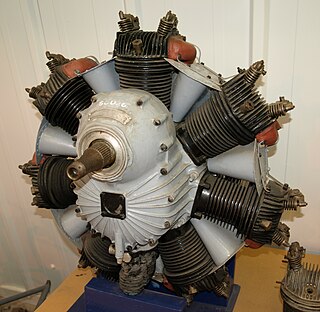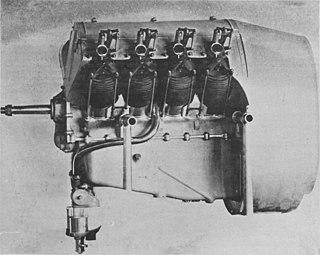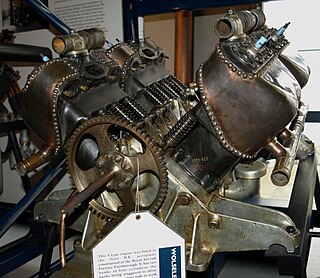
The Bristol Pegasus is a British nine-cylinder, single-row, air-cooled radial aero engine. Designed by Roy Fedden of the Bristol Aeroplane Company, it was used to power both civil and military aircraft of the 1930s and 1940s. Developed from the earlier Mercury and Jupiter engines, later variants could produce 1,000 horsepower (750 kW) from its capacity of 1,750 cubic inches by use of a geared supercharger.

The Bristol Perseus was a British nine-cylinder, single-row, air-cooled radial aircraft engine produced by the Bristol Engine Company starting in 1932. It was the first production sleeve valve aero engine.

The Taurus is a British 14-cylinder two-row radial aircraft engine, produced by the Bristol Engine Company starting in 1936. The Taurus was developed by adding cylinders to the existing single-row Aquila design and transforming it into a twin-row radial engine, creating a powerplant that produced just over 1,000 horsepower (750 kW) with very low weight.

The Armstrong Siddeley Leopard was a British 14-cylinder twin-row air-cooled radial aero engine developed in 1927 by Armstrong Siddeley. It was the most powerful radial engine in the world when introduced.

Between 1920 and 1951 the Société des Moteurs Salmson in France developed and built a series of widely used air-cooled aircraft engines.

The Armstrong Siddeley Genet Major is a British five-cylinder, air-cooled, radial engine for aircraft, designed and built by Armstrong Siddeley and first run in 1928. It developed 140 horsepower (104 kW). In Royal Air Force use the seven-cylinder version was known as the Civet I. The Feliform names used are in line with company convention, the Genet and Civet both being large cat-like carnivores.

The Bristol Titan was a British five-cylinder air-cooled radial engine, designed and built by the Bristol Aeroplane Company in the late 1920s. It had the same size cylinders as the earlier Bristol Mercury engine, 5.75 in x 6.5 in and produced between 200-240 hp. Later versions of the Bristol Titan also used a Farman-style reduction gear produced by Gnome-Rhône.

The Pobjoy R is a British seven-cylinder, radial, air-cooled, aircraft engine designed and built by Pobjoy Airmotors. Introduced in 1926 it was a popular engine for ultralight and small aircraft in the 1930s. A notable feature of the Pobjoy R was the propeller reduction gear which allowed the small engine to operate at more desirable higher speeds.

The Armstrong Siddeley Deerhound was a large aero engine developed by Armstrong Siddeley between 1935 and 1941. An increased capacity variant known as the Boarhound was never flown, and a related, much larger, design known as the Wolfhound existed on paper only. Development of these engines was interrupted in April 1941, when the company's factory was bombed, and on 3 October 1941 the project was cancelled by the Air Ministry.

The Renault 70 hp or Type WB was a French V-8 aero engine that first ran circa 1907. It was also manufactured under license by Renault Limited of West Brompton, London between August 1914 and December 1918, three other companies, including Rolls-Royce, also produced the engine. A variant known as the Type WC used an external oil pump as opposed to the internal pump of the Type WB. The Renault V-8 engines were noted as inefficient but reliable, the inefficiency being mainly due to the excessively rich fuel/air mixture used to assist cooling.

The RAF 4 was a British air-cooled, V12 engine developed for aircraft use during World War I. Based on the eight–cylinder RAF 1 it was designed by the Royal Aircraft Factory but produced by the two British companies of Daimler and Siddeley-Deasy. The RAF 5 was a pusher version of the same engine.

The Wolseley 60 hp or Type C was a British liquid-cooled V-8 aero engine that first ran in 1910, it was designed and built by Wolseley Motors. The engine featured water-cooled exhaust ports and employed a 20 lb (9 kg) flywheel. During an official four-hour test the engine produced an average of 55 horsepower. A larger capacity variant known as the 80 hp or Type B used an internal camshaft and propeller reduction gear.

The Wolseley Aries III or A.R.9 was a British nine-cylinder, air-cooled radial aero engine that first ran in 1933, it was designed and built by Wolseley Motors. Intended for the military trainer aircraft market few were produced as Wolseley withdrew from the aero engine market in 1936.

The Salmson 9 AD was a family of air-cooled nine cylinder radial aero-engines produced in the 1930s in France by the Société des Moteurs Salmson.

The Salmson AD.3 or Salmson 3 Ad was a French designed, three-cylinder, air-cooled radial aero engine. It was also produced by British Salmson in Great Britain during the 1920s.

British Salmson aero-engines refers to a series of small French designed, air-cooled radial aero engine that were produced by British Salmson Aero Engines Ltd, under license from Société des Moteurs Salmson, in Great Britain during the late 1920s and 1930s.

The Salmson water-cooled aero-engines, produced in France by Société des Moteurs Salmson from 1908 until 1920, were a series of pioneering aero-engines: unusually combining water-cooling with the radial arrangement of their cylinders.

The Gnome 7 Lambda was a French designed, seven-cylinder, air-cooled rotary aero engine that was produced under license in Britain and Germany. Powering several World War I-era aircraft types it was claimed to produce 80 horsepower (60 kW) from its capacity of 12 litres although recorded figures are lower.
The Gnome 7 Gamma was a French designed, seven-cylinder, air-cooled rotary aero engine. Powering several pre-World War I era aircraft types it produced 70 horsepower (52 kW) from its capacity of 12 litres.
The Farman F.30A C2 was a two-seat biplane designed as a fighter in France in 1916 and powered by a single, water-cooled radial engine. It showed poor flight characteristics and only one was built, though it was modified twice. It should not be confused with the similarly named Henry Farman HF.30 of 1915, a completely different aircraft which was used in large numbers by the Imperial Russian Air Service.
















